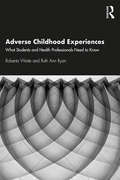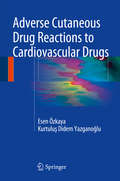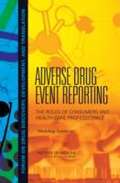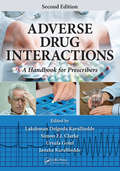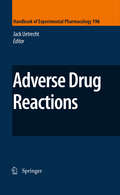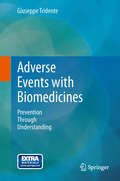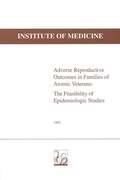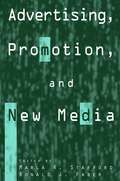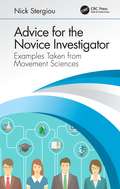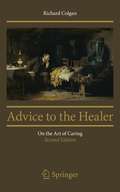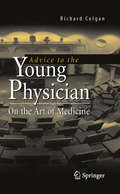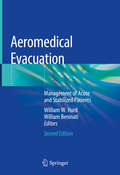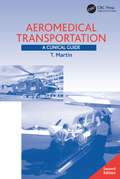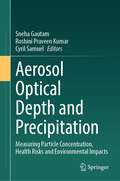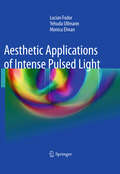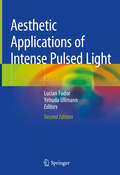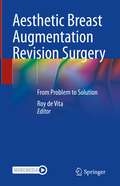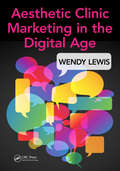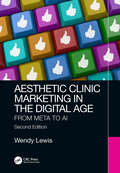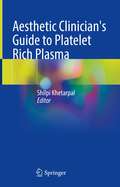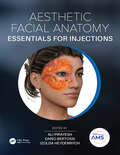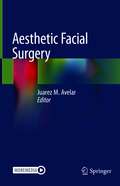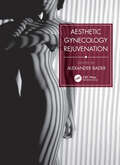- Table View
- List View
Adverse Childhood Experiences: What Students and Health Professionals Need to Know
by Roberta Waite Ruth Ann RyanThis guide provides healthcare students and professionals with a foundational background on adverse childhood experiences (ACEs) – traumatic early life experiences, which can have a profound impact on health in later life. ACEs can include being a victim of abuse, neglect or exposure to risk in the home or community. How healthcare students and professionals learn to recognize, react and respond to persons affected by trauma will lay the foundation for their relationships with patients. This book intentionally uses micro-to-macro lenses accompanied by a structural competency framework to elucidate health implications across the lifespan. It explores the nature of adversity and its effects on the physical, emotional, cognitive and social health of individuals, communities and society. The book, written by two experienced psychiatric nurses, will equip healthcare students and professionals with an understanding for critical change in practice and offer action steps designed to assist them with prevention and intervention approaches and steps to help build resilience. This book will be core reading for healthcare students within mental health, pediatric and primary care nursing courses. It will also be of interest to students and professionals in the social work, psychology and public health fields who are exploring resilience and trauma-informed practices
Adverse Cutaneous Drug Reactions to Cardiovascular Drugs
by Esen Özkaya Kurtuluş Didem YazganoğluAdverse cutaneous drug reactions (ACDR) are among the most frequent events in patients receiving drug therapy. Cardiovascular (CV) drugs are an important group of drugs with potential risk of developing ACDR especially in elderly as marketing of more new drugs and their prescription continue to increase. However, like with most other drugs the exact incidence of cutaneous side effects from CV drugs is difficult to estimate due to sporadic reporting. Moreover, a reliable designation of a certain drug as the cause of a certain type of reaction can rarely be made. Apart from the well-known angioedema/urticaria from ACE inhibitors, lichen planus / lichenoid reaction from beta adrenergic blockers and photosensitivity from thiazid diuretics, ACDR from CV drugs might be seen in a wide spectrum extending to rare but life-threatening conditions such as erythroderma, Stevens-Johnson syndrome, toxic epidermal necrolysis or drug hypersensitivity syndrome. In this comprehensive review, the reported types of ACDR to CV drugs will be discussed according to drug class and the type of dermatologic reaction with special emphasize on cross-reactions and the role of patch testing in diagnosis.
Adverse Drug Event Reporting: The Roles Of Consumers And Health-care Professionals
by Institute of Medicine of the National AcademiesThe National Academies Press (NAP)--publisher for the National Academies--publishes more than 200 books a year offering the most authoritative views, definitive information, and groundbreaking recommendations on a wide range of topics in science, engineering, and health. Our books are unique in that they are authored by the nation's leading experts in every scientific field.
Adverse Drug Interactions: A Handbook for Prescribers, Second Edition
by Simon Clarke Ursula Gotel nee Collignon Janaka Karalliedde Lakshman KarallieddeAdverse Drug Interactions: A Handbook for Prescribers assists clinicians by providing key information on potential adverse effects that can result from prescribing two or more drugs for simultaneous use. Interactions that are likely to give rise to life-threatening conditions, and which must therefore be completely avoided, are clearly highlighted.
Adverse Drug Reactions (Handbook of Experimental Pharmacology #196)
by Jack UetrechtThis book provides the current state of knowledge of basic mechanisms of adverse drug reactions (ADRs). The main focus is on idiosyncratic drug reactions because they are the most difficult to deal with. It starts with a general description of the major targets for ADRs followed by a description of what are presently believed to be mediators and biochemical pathways involved in idiosyncratic drug reactions. There is also a description of several examples of ADRs that serve to illustrate specific aspects of ADR mechanisms. Eventually the book shows that ultimately better methods are needed to predict which drug candidates are likely to cause ADRs and which patients are at increased risk. But at present research seems to be far from this goal.
Adverse Events with Biomedicines: Prevention Through Understanding
by Giuseppe TridenteThis monograph gathers and evaluates data on adverse events (AEs) associated specifically with those "biomedicines" - monoclonal antibodies, fusion proteins, and cytokines - that have recently entered therapeutic use in humans. All AEs observed when using each member of this new drug class are covered, with a view to improving understanding of pathogenesis, facilitating prevention, monitoring, and control, and contributing to the development of better drugs that provide benefits while minimizing risk. Further aspects here examined include the role of drug mechanisms of action and immunogenicity in relation to AEs outcome and induction of systemic syndromes. Additional data on AEs in off-label treatments are also considered. Electronic data sheets, downloadable from Springer Extra Materials platform, include more detailed safety data as well as additional basic information on product characteristics, pre- and post-marketing AEs classified according to frequency, and system/organ targeting. Data on excipients and selected information on drug interactions and associations are also provided. Adverse Events with Biomedicines: Prevention Through Understanding will serve as a detailed, practical guideline to this important new area, which demands the attention of clinicians, immunologists, oncologists, allergologists, public health professionals, and drug companies.
Adverse Reproductive Outcomes in Families of Atomic Veterans: The Feasibility of Epidemiologic Studies
by National Research CouncilOver the past several decades, public concern over exposure to ionizing radiation has increased. This concern has manifested itself in different ways depending on the perception of risk to different individuals and different groups and the circumstances of their exposure. One such group are those U.S. servicemen (the "Atomic Veterans" who participated in the atmospheric testing of nuclear weapons at the Nevada Test Site or in the Pacific Proving Grounds, who served with occupation forces in or near Hiroshima and Nagasaki, or who were prisoners of war in or near those cities at the time of, or shortly after, the atomic bombings. This book addresses the feasibility of conducting an epidemiologic study to determine if there is an increased risk of adverse reproductive outcomes in the spouses, children, and grandchildren of the Atomic Veterans.
Advertising, Promotion, and New Media
by Marla R. Stafford Ronald J. FaberToday, new media enter our lives faster than ever before. This volume provides a complete, state-of-the-art overview of the newest media technologies and how they can be used in marketing communications - essential information for any organization that wants to maintain an effective advertising program, as well as for experts and students in the fields of advertising and mass communications. Advertising, Promotion, and New Media offers crucial insights on the use of cutting-edge techniques including 3-D advertising, mobile advertising, advergames, interactivity, and netvertising images, as well as more familiar Internet advertising formats such as banner ads and pop-ups. It also discusses such important topics as how to select online affiliates, and how to assess the effectiveness of new media advertising and compare it with traditional formats. Throughout the book, the chapter authors offer up-to-date information and thought provoking ideas on emerging technology and how it can be used effectively for advertising and promotion in the future.
Advice for the Novice Investigator: Examples Taken from Movement Sciences
by Nick StergiouThis book is intended to help young and novice scientists by providing them with advice on how to overcome adversities. This advice comes in the form of numerous examples from the author’s career but also from the careers of many other scientists. It follows the thinking process of Ramon Y Cajal and his famous book, "Advice for a Young Investigator." It covers a variety of topics and areas that are fundamental in becoming a successful scientist. It presents chapters on all essential areas of the scientific life that appeal to a wide range of audiences, from the senior undergraduate student to the university administrator to the chief scientist in the industry. Some figures in the eBook are in color. Features Contains practical advice and many hints on a variety of topics; from how to write a grant to how to effectively manage your time Displays many examples of success and failure from other scientists that can teach valuable lessons Provides many personal stories and anecdotes in a form of sincere confessions Includes PowerPoint Presentation slides for each chapter for any academicians that want to develop such a class in their institutions
Advice to the Healer: On the Art of Caring
by Richard ColganThis book introduces the origins of important teachings that form the basis of medicine and related healing professions. Reinforcing the humanistic side of patient care, this book replicates the tips, anecdotes and aphorisms often related by mentors and educators to medical students, residents, and young physicians. This book provides numerous examples of best practices in the art of medicine, profiles of great healers throughout history and around the world, and stories sure to inspire any practicing healer, whether they are new to the calling or a seasoned veteran.
Advice to the Young Physician: On the Art of Medicine
by Richard ColganAdvice to the Young Physician introduces the origins of important teachings that form the basis of medicine as it has been taught by some of history's greatest educators in medicine. Advice to the Young Physician reveals how to make the transition from technician to healer. This book reinforces the humanistic side of patient care, which is often overshadowed by the focus on highly technological elements. Medical students, residents, fellows, physicians, and allied health practitioners often forget the intricacies of the genomic makeup of adenoviruses, yet they remember the tips, anecdotes and aphorisms related by mentors, educators, and experienced physicians. The art of medicine comes from insights gained from unique and dynamic experiences between the physician, an enthusiastic medical student and the human patient, and is rarely found in books or taught in a universal and systematic way. Advice to the Young Physician provides numerous examples of best practices in order to internalize and practice the art of medicine, including tenets taught by Hippocrates, Maimonides, Osler, Peabody, Schweitzer and others. Advice to the Young Physician targets aspiring and new physicians with the intent to make them better physicians. It hits the mark. An effective mix of the writings of some of medicine's giants, as well as clinical experiences of the author, the book offers an historical framework and personal context to understand the attributes and attitudes of the good physician. It is a quick read that rewards the reader with a sampling of 4000 years of medical wisdom sprinkled with practical advice for the modern day doctor. --Richard G. Roberts, MD, JD, Professor of Family Medicine, University of Wisconsin School of Medicine and Public Health, President World Organization of Family Doctors, Past President American Academy of Family Physicians This is a small book and easy to read. It comprises several inspiring sketches of ancient and modern physicians whose reputations were based as much on their dedication to the humanism of medicine as it was to the science of medicine. Those who teach medical students and residents will find it a good source of medical history that, besides being important in itself, will add a new dimension and a little lightness to morning rounds. The author makes it clear that in our era of high technology it is easy to underestimate the importance of uniting humanism with science in caring for the sick. He also provides some practical information on such topics as how to present a case to attending physicians and how to communicate well with patients. The ancient physicians that history remembers were not only astute observers of signs and symptoms but also were deeply concerned about the psychological health of their patients and how disturbances in their emotional health often manifested in physical symptoms. Colgan starts with Hippocrates and Maimonides whose names many young physicians are familiar with. The former for the aphorism "first do no harm" and the latter for being one of the first to call medicine a "vocation" and a "calling." The following "greats" are included in the book: Dr Albert Schweitzer whose "reverence for life" led him to his missionary medical work in Africa. He wrote Out of My Life and Thought and received the Nobel Peace Prize in 1952. Sir William Osler (1849-1919), known to some as the father of internal medicine, was a respected physician and teacher. He was the author of the Principles and Practice of Medicine, used for decades as the bible of medicine. But his fame rested equally on his dedication as a mentor to young physicians. He often gave graduation addresses to medical students reminding them to maintain a life-long interest in continuous learning and to treat the whole patient not just the disease. Francis Weld Peabody (1881-1927) a teacher at Harvard who had written a book The Care of the Patient in which he discussed how older practitioners often complained that younger doctors' mindsets were so often over-concerned with testing that they sometimes fo...
Aerodynamics of Tandem Wing Aircraft: From Dinosaurs to UAVs and Supersonic Planes
by Illia KryvokhatkoThis book contains extensive data about tandem wing aircraft. It includes a review of modern flying vehicles with four fixed wings, a review of analytical, numerical and experimental methods; results of the studies about aerodynamics; dependencies between geometrical parameters and aerodynamic characteristics, practical recommendations in development and optimizing of tandem wing aircraft to provide high lift-to-drag ratio, stability, and controllability. This is an ideal book for graduate students, researchers, and engineers working in fields of aerodynamics and conceptual design of the aircraft especially UAVs, ground-effect vehicles, and convertiplanes.
Aerodynamics of Tandem Wing Aircraft: From Dinosaurs to UAVs and Supersonic Planes
by Illia S. KryvokhatkoThis updated, second edition adds more reviews of modern four-winged aircraft belonging to convertiplanes, Medium Altitude Long Endurance UAVs, and solar planes. As in the first edition, different analytical, numerical, and experimental methods are discussed in detail. The book presents new sections on unsteady aerodynamic characteristics of tandem wings and specifics of their aerodynamic loading for stress analysis and structural design. Also, dependencies between key geometric parameters and aerodynamic characteristics were updated with new studies that helped to understand the physics more deeply and even reinterpret previous experimental results. Accordingly, practical recommendations in development and optimizing of tandem wing aircraft were updated to provide high endurance, wide range of flight velocities, stability, and controllability. This is an ideal book for graduate students, researchers, and engineers working in fields of aerodynamics and conceptual design of the aircraft especially UAVs and light piloted airplanes.
Aeromedical Evacuation: Management of Acute and Stabilized Patients
by William W. Hurd William BeninatiThe definitive treatment on the medical evacuation and management of injured patients in both peace- and wartime. Edited by eminent experts in the field, this text brings together medical specialists from all four branches of the armed services. It discusses the history of aeromedical evacuation, triage and staging of the injured patient, evacuation from site of injury to medical facility, air-frame capabilities, medical capabilities in-flight, response to in-flight emergencies, and mass emergency evacuation. Specific medical conditions are addressed in detail, including such general surgical casualties as abdominal wounds and soft tissue, vascular, maxillofacial, head and spinal cord injuries, ophthalmologic, orthopaedic, pediatric, obstetric-gynecologic casualties, burns, and more. Over 80 illustrations provide a review of transport equipment and both medical and surgical treatment. A must-have reference for all armed forced physicians and flight surgeons, for general and trauma surgeons, internists, intensive care specialists, orthopaedic surgeons, and public health service physicians.
Aeromedical Transportation: A Clinical Guide
by T. MartinStill the only book published anywhere in the world which is devoted entirely to the principles of aeromedical transport, Aeromedical Transportation has rightly become known as the sole reference for the industry. This second edition has been radically revised and updated; featuring the latest research, updated references and new chapters on the transport of intensive care patients, and medical emergencies/death in flight. Since the first edition was published in 1996, the concept of 'evidence-based medicine' has been accepted as essential in any book which endeavours to be the accepted knowledge base in its subject area. A very practical text, international in its approach, much of its content is devoted to clinical matters. Administration and organisation are also discussed, but are addressed from the standpoint of the clinical aeromedical escort. The text is suitable for medical, paramedical and nursing personnel and for those working in organizations whose duties include the transportation of the sick and injured by air.
Aerosol Optical Depth and Precipitation: Measuring Particle Concentration, Health Risks and Environmental Impacts
by Sneha Gautam Cyril Samuel Roshini Praveen KumarThis volume uses aerosol optical depth (AOD) analysis through mapping and remote sensing techniques to derive the relationship between aerosols and hazardous precipitation events, primarily in the form of flooding. Attention is also given to pollution caused by an abundance of particulate matter in the atmosphere and its impacts on human health, which is also assessed via the study of AOD. Background is given on how AOD is retrieved, and why it is a useful tool for estimating atmospheric particle concentration, but also the challenges associated with using this approach. Different aerosol types are introduced to perform a comparative analysis of the most common associations between pollution impacts on temperature and resulting precipitation events. These analyses will help to provide an overview of the best strategies to make informed and sustainable disaster risk management practices and policies. The target audience for the work is students, researchers, and scientists working witha vision towards sustainability, public health safety and air pollution mitigation measures. It will also be a useful text for climate change policy makers, environmental engineers and stakeholders in social development sectors.
Aesthetic Applications of Intense Pulsed Light
by Yehuda Ullmann Monica Elman Lucian FodorThe book is structured into eight chapters: 1. Skin anatomy. This chapter is intended to describe the pertinent anatomy related to IPL applications. In addition to the described main structural elements of the skin, the chapter has important points about skin aging and histological aspects which gives the reader a better understanding of the etiology of skin lesions and the need for Intense Pulsed Light (IPL) treatment. 2. Light-tissue interaction. This chapter describes the interaction between IPL and different skin structures. Target skin structures (chromophores) are described in detail. The results of this interaction are detailed as being important to understanding the goals and principles of IPL treatment. 3. IPL safety and legal issues. This chapter describes the needs of the environment for a safe treatment. The necessary equipment and things to avoid pitfalls which may lead to lawsuits are detailed. Several aspects of IPL legal issues are also described: how to avoid medical liabilities and how to manage them are also included in this chapter. 4. Patient selection. This chapter describes the pearls and pitfalls in selecting patients for IPL treatment. This is not an easy task and proper patient selection is extremely important to have satisfied patients. Problematic patient types are also described here. 5. Skin rejuvenation. This chapter starts with a description of skin aging. Intrinsic and extrinsic mechanisms are detailed. The most common skin lesions related to aging that can benefit from IPL treatment for rejuvenation are detailed. The chapter continues with treatment protocols which describe strategies for achieving optimal results. A review of the literature is included, presenting the treatment parameters of different studies and their results. 6. Hair removal. This chapter starts with a description of the hair follicle cycle, hair types and important structures for treatment. Treatment strategies are emphasized and detailed, starting from choosing the right parameters to post-treatment recommendations. A literature review is presented regarding treatment parameters and results according to different authors. 7. Vascular lesions treatment. This chapter describes the types of vascular lesions that can benefit from IPL treatment. The treatment protocol is emphasized and all the steps for performing this application are described in detail. A literature review is presented and different results are compared regarding treatment parameters. 8. Complications. It is inevitable that any medical treatment can end with complications. The possible complications of the most common IPL applications (skin rejuvenation, hair removal, pigmented and vascular lesion treatment) are detailed. The way to avoid them and how to handle them is also described. At the end of each chapter, there is a section on the practical points highlighting the most important points of the chapter. An extensive literature review of this technology is presented alongside numerous illustrations, tables and color pictures. The book will benefit any doctor or healthcare professional who uses IPL for cosmetic purposes, such as plastic surgeons, dermatologists, ophthalmologists, maxillofacial surgeons and otolaryngologists dealing with aesthetics of the face, as well as residents interested in learning the subject.
Aesthetic Applications of Intense Pulsed Light
by Yehuda Ullmann Lucian FodorThis significantly revised second edition provides a practical guide to applications of Intense Pulsed Light (IPL) in aesthetic and non-aesthetic field. It features revised chapters focusing on skin anatomy, light tissue interactions and legal issues associated with IPL safety. New topics covered include the use of IPL for rosacea, pigmented lesions, scars and stria distensae. Key points are emphasized through the inclusion of learning objectives at the beginning and review questions at the end of each chapter. Aesthetic Applications of Intense Pulsed Light systematically describes the aesthetic applications of IPL in practice and includes extensive didactic material to assist the trainee looking to develop their knowledge of IPL applications and the experienced practitioner looking for an up-to-date resource on the subject.
Aesthetic Breast Augmentation Revision Surgery: From Problem to Solution
by Roy De VitaThis book deals with the management of difficult breast augmentation revision cases. After critically reviewing the complication rate in aesthetic breast augmentation, the authors go on to discuss the importance of the inframammary fold. Moreover, this book provides detailed instructions on how to manage capsular contracture; wrinkling; animation deformity; implant rotation and waterfall deformities; symmastia; implant rupture; infection and implant exposure; double bubble; and bottoming out. Each chapter starts with a short explanation of the complication, followed by step-by-step revision procedures. Checklists, high-quality images, flowcharts and bullet point-like presentations will help surgeons solve these various problems. Well-structured chapters and a concise format make this book a quick reference guide that aids clinicians in making decisions and providing treatment.
Aesthetic Clinic Marketing in the Digital Age
by Wendy LewisSocial media provides a new way for aesthetic practitioners to connect with consumers and to differentiate their clinics. However, to most clinic managers and practitioners, digital media represents a sea of confusion that they cannot even begin to know how to navigate. With over 20 years of experience in medical aesthetics, Lewis offers a unique understanding of the challenges clinics face every day to market their products and services ethically, manage patients and stay profitable. This text serves as an expert user's guide written specifically for healthcare professionals in need of an in-depth introduction and comprehensive actionable program for digital marketing, social media, and aesthetic clinic management. It is a must-read for practitioners.
Aesthetic Clinic Marketing in the Digital Age: From Meta to AI
by Wendy LewisAesthetic practitioners and medical spas have flourished, and global statistics indicate that consumer engagement is at an all-time high. The rise of social media provides new ways to connect with consumers and differentiate clinics that stand out in the marketplace. For busy clinic managers and practitioners, keeping up with the nuances of digital media trends is practically a full-time job. With over 25 years of experience in medical aesthetics, Wendy Lewis shares her deep understanding of the challenges aesthetic practitioners face to effectively market their products and services, manage patients, and increase profits. This updated text is the definitive expert user’s guide written specifically for healthcare professionals and medical spa managers to present best practices and actionable strategies for mastering digital marketing, social media, branding, and the advent of AI. It is a must-read for aesthetic practitioners to keep up with the latest developments they need to manage their businesses effectively in this highly competitive field.This second edition features: NEW chapters on hot topics you need to know MORE tips, charts, tables, and resources UP-TO-THE-MINUTE strategies for success
Aesthetic Clinician's Guide to Platelet Rich Plasma
by Shilpi KhetarpalPlatelet rich plasma therapy uses a patient's own platelets to encourage and accelerate healing in a variety of tissues. With the growing popularity of using platelet rich plasma for aesthetic procedures, the need for a book that ties together all of the current literature in one place has become more pressing. This book fills in that gap as a comprehensive guide that covers history, basic science and clinical utility of platelet rich plasma with its uses in hair restoration, facial rejuvenation, and some wound healing. It includes the latest studies/literature from peer reviewed journals and clinical, anecdotal experience. Chapters provide an extensive look at how to describe the mechanism of action of platelet rich plasma (PRP) in the skin and hair; how to identify the difference between PRP, platelet rich fibrin, and stem cells; and identify the various PRP preparation systems and how to calculate dosing. Aesthetic Clinician's Guide to Platelet Rich Plasma is written especially for the aesthetic clinician, whether dermatologist or plastic surgeon. This book will find utility across specialties and with it's extensive coverage it is a vital reference.
Aesthetic Facial Anatomy Essentials for Injections (The PRIME Series)
by Ali Pirayesh Dario Bertossi Izolda HeydenrychWith the ever-increasing popularity of injectable toxins and fillers, all clinical practitioners in minimally invasive aesthetic procedures need to be experts in the anatomy of the face. This is a detailed and informative guide from international experts to all aspects of the facial anatomy of the presenting clinical patient - how it changes with age, how it differs in different patients, how it is layered, and what danger zones it may contain. An integral ebook contains videos demonstrating how injection can best be accomplished in each of the anatomical areas considered
Aesthetic Facial Surgery
by Juarez M. AvelarRhytidoplasty is a palliative procedure in which face wrinkles are surgically removed to promote a more youthful appearance. This book, written by leading specialists for Brazil and abroad, discusses a wide variety of topics related to facial rejuvenation. The first sections focus on the surgical planning, including psychological considerations, preparation of the patient and anatomical and biochemical changes caused by the aging process. It also describes the surgical anatomy of the forehead, face, neck and eyelids. The third section provides a comprehensive overview of the basic techniques of facelift with details of refined surgical approaches for each segment of the face and neck. It highlights liposuction techniques, lipo-injection as well as transference of stem cells, showing their importance in reshaping the facial contours. It addresses both the treatment of soft tissue and craniofacial bone structures to improve the aesthetics of the face. The next sections present the final scars after face-lifting, minimally invasive procedures as complementary approaches during rhytidoplasty and the associated procedures during rhytidoplasty. The last section discusses postoperative care. Aesthetic Facial Surgery consists of 64 chapters focusing on all aspects of face lifting, and meticulously describes surgical details not covered in other medical books. Featuring numerous figures, photographs and videos, it is a valuable resource for young and experience surgeons alike around the world.
Aesthetic Gynecology Rejuvenation
by Alexander BaderAesthetic Gynecology is a fast-growing market amid much new demand from patients since gynecological defects can have considerable impact on their quality of life. This fully illustrated text provides an authoritative guide from international experts on the anatomical, functional, and medical aspects, details the surgical treatments, and documents the clinical and procedural points arising.
